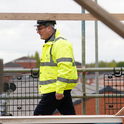There aren’t many places in England where you can go to watch your local village team and see some of the highest level of play in the whole country. But the market town of Grassington in the Yorkshire Dales is one.
It is home to Wharfedale rugby club, founded in 1923, which has achieved what so many sports clubs only dream of doing. It is as local and rooted as a village team can be. In the clubhouse hang team photographs stretching back to the 1930s, with the same names cropping up decade after decade: Harrison, Hartley, Rymer, Baker and more. Men from two of those families are still closely involved in running the club.
Yet Wharfedale also had an extraordinary burst of success from the mid-1980s to the mid-1990s, masterminded by local sheep farmer and then coach Mike Harrison, along with the late Peter Hartley. It sailed up the local and regional leagues to reach the semi-professional third tier of English rugby union, now called National League 1, just below the two top professional rugby leagues (the Premiership and the Championship). Here in “national one,” alongside teams like London Scottish, Coventry, Blackheath and Rosslyn Park, is where it has remained for the past 15 seasons. With a bit of luck, it should hang on for a 16th.
And Wharfedale has achieved this without losing its soul. In early April I went to the club’s ground near Grassington, surely the most picturesque in the country, to watch a bottom-of-the-table scrap between Wharfedale and Launceston (the Cornish All Blacks). Before the game, the former England and Lions player John Spencer, president of the club and a solicitor, talked me through the Wharfedale team sheet. He calculated that about two thirds of the team were homegrown players who had risen through the junior teams or played for one of the three other senior teams that the club puts out every Saturday. “For most of the other teams in national one that proportion of homegrown talent would be much lower. Quite a few of them don’t even have a second team let alone the junior rugby system that we have,” says Spencer.
If you visit the ground on a Sunday morning you’ll see at least 100 boys and a few girls, aged from seven to 17, chasing after rugby balls. The man in charge of the club’s academy is 38-year-old Hedley Verity, Wharfedale’s most capped player, who takes the rugby gospel into nearby schools. Several local players have ended up in Premierships teams such as Sale and Newcastle, and Mike Harrison’s son Daniel was until recently head of rugby at Sedbergh School in Cumbria, which has produced a prodigious number of England players.
But Wharfedale is a financial tiddler. The big clubs in National League 1 have turnovers of around £1.5m and pay decent salaries to their (20 or so) professional players. Wharfedale’s turnover is about £200,000 and its players’ match fee is £80—the same for everyone—plus travel expenses. That is probably the lowest in the league and, when you factor in two training sessions a week, works out at less than the minimum wage. Verity is the only person who comes close to being a full-time club employee (and his salary is mainly paid by the Skipton Building Society).
But that’s how they want it to be. In some ways this is an outpost of high-grade amateur rugby, based on the solid professional middle class of north Yorkshire, a place which still has grammar schools (many people associated with the club went to Skipton grammar school). Most of Wharfedale’s players, coaches and managers are farmers, teachers, solicitors, students and small businessmen. They like being a focus for Dales pride.
As I watched the game against Launceston in the April sunshine, surrounded by about 600 boisterous and mainly prosperous looking locals, it struck me that this is an example of England’s mittelstand at play. Germany is full of small towns with first-class businesses and well-established local elites, who believe in passing on their know-how to the next generation. They combine rootedness and success in a way that seems harder in England, with the great pull of London and the other conurbations.
Wharfedale exemplifies the virtues of non-metropolitan Britain. But the area currently feels under siege from the metropolis, thanks to a Channel 4 reality TV show called Love Thy Neighbour. The idea is that 12 couples—many of them from ethnic minority or non-mainstream backgrounds—compete to win the affections and votes of Grassington’s 1,500 residents, with the prize being a cottage in the town. Almost everyone in Grassington hates the programme, feeling that they have been set up to come across as dim and prejudiced.
As far as I could see they are neither of those things, merely anxious to preserve what is good about their community—symbolised above all by the rugby club. So anxious is the club to hang on to its roots that most people who matter—Mike Harrison (now chairman of rugby), John Spencer, even the sponsors—are ambivalent about taking the next step up the ladder to the fully professional Championship. That would mean buying players and breaking the links with the feeder teams in lower divisions. “Of course we want to encourage excellence, but we also want to be able to stay a community club—you know the guy who clips my sheep is also the second team coach,” says Harrison, whose family trace their local roots to the 13th century.
For now, promotion is the last thing on their minds. In an exciting end-to-end game against Launceston—and despite a brilliant try by Wharfedale’s Andy Hodgson (an ex-professional rugby league player)—the home team lost 10-12. After that match, Wharfedale was one place above the relegation zone. Survival is now the priority; the season ends on 21st May. But having witnessed the spirit of the place I would bet a lot of money on them staying up. The club motto is “strength comes from the mountain.” Come on Dale!

Sporting life
Wharfedale has reached the third highest tier in rugby union without giving up its local roots. But how long can it keep it up?
April 20, 2011











